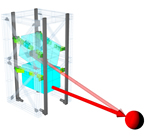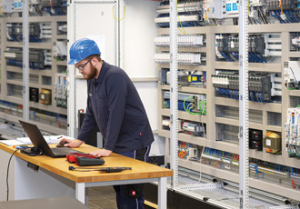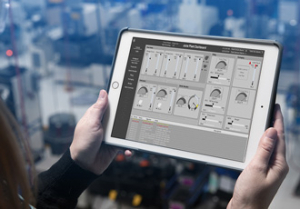LMS ServoTechnics apply mathematics to reduce mechanical complexity for machine building
4th June 2013
Source:
Trio Motion Technology

LMS ServoTechnics work across the automation spectrum, providing its customers with automation system solutions that often call for a lateral thinking approach. Two recent applications demonstrate the benefits of looking at applications from a mathematical and motion control viewpoint to reconsider the best mechanical system solution.
Both
examples have reduced cost and complexity of the mechanical set-up in a trade-off for more complex control but with reduced overall costs. They also maintained straightforward machine operator control where easily understood ‘real unit’ parameters are transformed into compound motion positions using the power of Trio Motion MC series controllers.
Lateral thinking moves ‘outside the box’
Boldman Limited is one of the UK's leading suppliers of bespoke access solutions, providing work platforms and towers for a variety of industries that ensure maximum safety when working at height. For a recent project for BAe Systems, they were called upon to build a pair of 12 metre high towers to vertically lift and support a large 30 m3, 2.5 tonne box structure containing measuring equipment. A point of reference located on the equipment and within the closed box structure needed to be precisely positioned to an accuracy of less than one millimetre and 0.1 degrees over several metres of vertical travel, by progressively tilting the equipment to maintain its alignment to a target located away from the measuring equipment.
A traditional mechanical solution to tilt the equipment about the required reference point would have necessitated a large rotary positioning axis aligned through the horizontal axis of the point. This would demand that the mechanical system – a rotary table or a large motor-gearbox – and its drive system was lifted along with the 2.5 tonne box. This traditional concept would have entailed a more robust tower and a box structure with increased weight that would require more lifting power and add considerable costs to the solution. So, a lateral, and (please excuse the pun) ‘out of the box’ approach was considered and employed.
Working with engineers at Boldman and BAe systems, LMS devised that the box structure itself, which anyway needed to be lifted vertically, could be tilted by independently driving it around horizontal pivot points at its front and rear. By fixing the measuring equipment in a known position and arranging the vertical drive elements with two front and two rear fully synchronised linear actuators positioning the box from these pivot points, it was a relatively simple task to calculate the trigonometry to maintain the point of reference on the measuring equipment as the tower is elevated and lowered.
With the positional relationship between the linear actuators and the point of reference designed around a cost effective belt driven actuator system, LMS set about sizing the application using Stober servodrives and motors with absolute encoder feedback coupled to Stober precision quality helical bevel gearboxes. Providing the required precision and torque ratings for such a large piece of equipment, the final design revealed the known geometry of the mechanical system and the formula to calculate the reference point was developed using a simple spreadsheet.
In itself, the spreadsheet was very useful for developing the maths model but the beauty of the application is that Trio Motion MC series controllers feature powerful maths functions that are able to employ such complex formulae. And thus, with a very simple TrioBASIC code, translate the desired vertical and rotary coordinates for the reference point into absolute linear distances required for each pair of synchronised actuators. Furthermore, through its 64-bit servo control and absolute encoder feedback, the MC Motion Coordinator maintains a very accurate target position even whilst the vertical axis is translated. The application was developed by LMS using Trio’s Motion Perfect configuration and connectivity software with TrioBASIC code in the MC series motion controller interfaced to a Pro-face HMI. The program simply allows the operator to request the measuring instrument to maintain its required height and angle. In another mode, the operator may enter the vertical position in millimetres and the system determines the angle so that the measuring instrument is pointing directly at the centre of a moving target which could be up to 12 metres away.
A further benefit of the machine’s simplified mechanical system is that the reference point on the measuring equipment can very easily be changed by simply adjusting the formula. This means that the complete test stand has the flexibility to adapt for different test piece designs should the need arise – something that would have entailed physically and expensively redesigning and moving the rotary positioner in the traditional solution.
Angular to linear transformation
LMS ServoTechnics also applied its lateral thinking methodology to determine an angular to linear transformation solution for another of its customers when a new requirement for a critical volume manufactured component was too large for their current machines which were based on rotary tables. To use the same production process as similar but smaller angular dimensioned component s, the resulting machine volumes would be impractically large and very expensive to produce.
LMS worked closely with mechanical engineers at the company to develop a novel linear X-Y positioning system with an additional interpolated linear axis and a pivoted tooling base where the workpiece is effectively rotated to achieve angular positions during the machining process. The heavy duty positioning system is driven by Stober rotary servo motors with built in encoder feedback driving precision ballscrews with the moving carriage supported on linear motion guide bearings. As the mechanical system was designed and developed using these components, its geometry could be used to generate the angular-to-linear transformation coordinates in a spreadsheet based formula that would be transferred into the Trio motion controller to position the special table into each position - rapidly and to within an accuracy of less than 10 microns.
For this application, the mathematical relationship is much more involved, but effectively the MC series controller works in a similar way to that of the BAe positioning system. Here the operator enters information for the finished product, in terms of part references as well as angular and linear position information for supplementary machining features. To accommodate these more complex requirements, additional information is downloaded and stored in the MC4 controller memory at the start of the process.
Lawrence Mummery-Smith of LMS comments, “For both applications, the operator doesn’t need to know anything about how the machine works. This is an important point - and in my opinion how a machine operator interface needs to be.” The more complex control allows simplified mechanics but does not have to be expensive, as Mummery-Smith explains, “Whilst the trade-off for the simplified mechanics was an increase in the complexity of calculating the required positions, using simple maths and the feature-rich Trio Motion MC Series motion controllers make these applications possible with very competitive overall costs when taking in all aspects of application development.”
The smaller and much more elegant solution was developed as an add-on to an existing production machine, saving considerable costs over the potential large rotary table solution. Additional benefits also included increased positioning precision - as in general linear precision positioners can achieve higher accuracy than rotary table driven machines - where backlash and other lost motion tends to be more prevalent. The new adapted machine can be also used for manufacture of similar components of all sizes, so opening up increased production across the customer’s full range of production.
Lateral thinking moves ‘outside the box’
Boldman Limited is one of the UK's leading suppliers of bespoke access solutions, providing work platforms and towers for a variety of industries that ensure maximum safety when working at height. For a recent project for BAe Systems, they were called upon to build a pair of 12 metre high towers to vertically lift and support a large 30 m3, 2.5 tonne box structure containing measuring equipment. A point of reference located on the equipment and within the closed box structure needed to be precisely positioned to an accuracy of less than one millimetre and 0.1 degrees over several metres of vertical travel, by progressively tilting the equipment to maintain its alignment to a target located away from the measuring equipment.
A traditional mechanical solution to tilt the equipment about the required reference point would have necessitated a large rotary positioning axis aligned through the horizontal axis of the point. This would demand that the mechanical system – a rotary table or a large motor-gearbox – and its drive system was lifted along with the 2.5 tonne box. This traditional concept would have entailed a more robust tower and a box structure with increased weight that would require more lifting power and add considerable costs to the solution. So, a lateral, and (please excuse the pun) ‘out of the box’ approach was considered and employed.
Working with engineers at Boldman and BAe systems, LMS devised that the box structure itself, which anyway needed to be lifted vertically, could be tilted by independently driving it around horizontal pivot points at its front and rear. By fixing the measuring equipment in a known position and arranging the vertical drive elements with two front and two rear fully synchronised linear actuators positioning the box from these pivot points, it was a relatively simple task to calculate the trigonometry to maintain the point of reference on the measuring equipment as the tower is elevated and lowered.
With the positional relationship between the linear actuators and the point of reference designed around a cost effective belt driven actuator system, LMS set about sizing the application using Stober servodrives and motors with absolute encoder feedback coupled to Stober precision quality helical bevel gearboxes. Providing the required precision and torque ratings for such a large piece of equipment, the final design revealed the known geometry of the mechanical system and the formula to calculate the reference point was developed using a simple spreadsheet.
In itself, the spreadsheet was very useful for developing the maths model but the beauty of the application is that Trio Motion MC series controllers feature powerful maths functions that are able to employ such complex formulae. And thus, with a very simple TrioBASIC code, translate the desired vertical and rotary coordinates for the reference point into absolute linear distances required for each pair of synchronised actuators. Furthermore, through its 64-bit servo control and absolute encoder feedback, the MC Motion Coordinator maintains a very accurate target position even whilst the vertical axis is translated. The application was developed by LMS using Trio’s Motion Perfect configuration and connectivity software with TrioBASIC code in the MC series motion controller interfaced to a Pro-face HMI. The program simply allows the operator to request the measuring instrument to maintain its required height and angle. In another mode, the operator may enter the vertical position in millimetres and the system determines the angle so that the measuring instrument is pointing directly at the centre of a moving target which could be up to 12 metres away.
A further benefit of the machine’s simplified mechanical system is that the reference point on the measuring equipment can very easily be changed by simply adjusting the formula. This means that the complete test stand has the flexibility to adapt for different test piece designs should the need arise – something that would have entailed physically and expensively redesigning and moving the rotary positioner in the traditional solution.
Angular to linear transformation
LMS ServoTechnics also applied its lateral thinking methodology to determine an angular to linear transformation solution for another of its customers when a new requirement for a critical volume manufactured component was too large for their current machines which were based on rotary tables. To use the same production process as similar but smaller angular dimensioned component s, the resulting machine volumes would be impractically large and very expensive to produce.
LMS worked closely with mechanical engineers at the company to develop a novel linear X-Y positioning system with an additional interpolated linear axis and a pivoted tooling base where the workpiece is effectively rotated to achieve angular positions during the machining process. The heavy duty positioning system is driven by Stober rotary servo motors with built in encoder feedback driving precision ballscrews with the moving carriage supported on linear motion guide bearings. As the mechanical system was designed and developed using these components, its geometry could be used to generate the angular-to-linear transformation coordinates in a spreadsheet based formula that would be transferred into the Trio motion controller to position the special table into each position - rapidly and to within an accuracy of less than 10 microns.
For this application, the mathematical relationship is much more involved, but effectively the MC series controller works in a similar way to that of the BAe positioning system. Here the operator enters information for the finished product, in terms of part references as well as angular and linear position information for supplementary machining features. To accommodate these more complex requirements, additional information is downloaded and stored in the MC4 controller memory at the start of the process.
Lawrence Mummery-Smith of LMS comments, “For both applications, the operator doesn’t need to know anything about how the machine works. This is an important point - and in my opinion how a machine operator interface needs to be.” The more complex control allows simplified mechanics but does not have to be expensive, as Mummery-Smith explains, “Whilst the trade-off for the simplified mechanics was an increase in the complexity of calculating the required positions, using simple maths and the feature-rich Trio Motion MC Series motion controllers make these applications possible with very competitive overall costs when taking in all aspects of application development.”
The smaller and much more elegant solution was developed as an add-on to an existing production machine, saving considerable costs over the potential large rotary table solution. Additional benefits also included increased positioning precision - as in general linear precision positioners can achieve higher accuracy than rotary table driven machines - where backlash and other lost motion tends to be more prevalent. The new adapted machine can be also used for manufacture of similar components of all sizes, so opening up increased production across the customer’s full range of production.
Similar articles
More from Trio Motion Technology
- Trio displays Mini EtherCAT master controlling 12 Drives from different manufacturers on one network 3rd October 2014
- LMS ServoTechnics apply mathematics to reduce mechanical complexity for machine building 4th June 2013
- Trio Motion updates Motion Perfect v3 application development interface to include single-point HMI programming 14th May 2013
- Trio launch all new Motion Perfect v3 configuration and application development tool for MC4 range Motion Coordinator 12th June 2012
Product Centre Updates
2024 World Battery & Energy Storage Industry Expo (WBE)
8th August 2024
China 1st and 2nd Floor, Area A, China Import and Export Fair Complex




 technology at Jacobs Vehicle Systems.JPG)







Write a comment
No comments